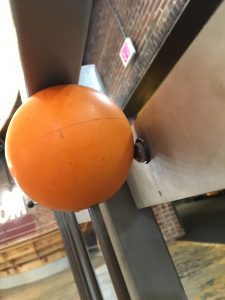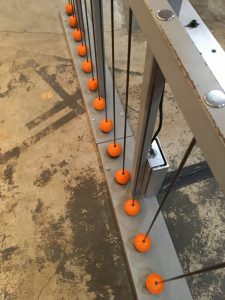This exhibit consists of a series of bright orange rubber balls that fall in a cascade when a lever is pulled. The mechanism behind it consists of a small metal bit that presses against the ball when the exhibit is at rest, holding the ball still. When the lever is pulled, the metal bit retracts, releasing the ball which falls along its metal-rod-defined course.
 (ball at rest)
(ball at rest)
 (closer look at metal bit)
(closer look at metal bit)
This exhibit is located right at the entrance of the garage room, adjacent to the wheel-making station. The simplicity of it makes it operable by younger children, and the bright orange color attracts all audiences. Since younger audiences are more enthusiastic to play with things that are brightly colored than things that have lots of small parts and requires assembling, the closeness of these two exhibits separates the crowd into younger and older audiences. This is, however, without accounting for popularity: if one exhibit has a crowd, chances are it will attract even more people, and the exhibits nearby only get explored after the crowd collectively loses interest in the first exhibit.
The simplicity of the orange ball exhibit would logically make it the more popular exhibit: you pull a lever, you watch the balls fall. The sense of accomplishment at having made something happen is easy to obtain, and the cascading and bouncing of the balls extend that joy beyond simply watching objects fall. However, the exhibit receives surprisingly little traffic. The main problem is that although the cause and effect is easy to understand after seeing the mechanism in motion for the first time, people rarely reset the exhibit. Kids will run straight for it when they walk into the garage room, head for the lever, pull it, and watch for something to happen. If the balls aren’t set back in their locked-and-loaded position behind the metal bits, nothing will happen, and the kids will lose interest in their confusion. The bright bouncy balls don’t seem as interesting to adults as they do to children, and parents will take a quick look at their kid repeatedly pulling the lever and urge them onto the next station if they can’t figure out how to fix the problem in that first glance.
When the balls are reset, the exhibit tends to get a surge of popularity, since most slightly older children will immediately understand that they’re supposed to slide the balls back up the poles if they’ve watched them cascade down, and the pleasing movement of the bright orange will call other kids and their parents to a closer examination of this exhibit. More outgoing kids/older kids will ask the people around them to help reset all the balls, younger kids and adults alike will usually gladly help in this endeavor. Kids will take turns (sort of) to pull the lever, and the exhibit quickly becomes a community affair. But eventually people lose interest because the reward is almost too little for the effort it takes to reset everything. When the crowd however, it takes a very long time before someone re-resets the exhibit. This person is usually a kid who has already played with it and wants to play with it one more time before leaving the garage room (or a college student initiating the resetting for observation/research purposes.)
Adults will see it as a simple exhibit, and will sometimes try to get very young children to play with it if their older siblings are busy doing other things. In that case, the child needs help, but otherwise the child usually takes charge, and might ask the adults to help reset the balls, or simply do it all themselves. Adults tend to step back and watch, a very different approach than that required by the exhibit right next door, the wheel-making station, which requires a lot of adult guidance and patience.

Leave a Reply
You must be logged in to post a comment.